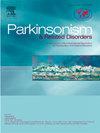Validating new symptom emergence as a patient-centric outcome measure for PD clinical trials
IF 3.1
3区 医学
Q2 CLINICAL NEUROLOGY
引用次数: 0
Abstract
Introduction
Tracking of emergent symptoms (ES) in de novo Parkinson Disease (PD) patients using Parts Ib and II of the MDS-UPDRS rating scale has been proposed as an outcome measure for PD clinical trials, based on observations in the Safety, Tolerability and Efficacy Assessment of Isradipine for PD (STEADY-PD3) clinical trial.
Methods
Individual item-level data was extracted from the SURE-PD3 study (coded as “PD-1018” in the C-path pooled dataset). We sought to confirm the observations made in the STEADY-PD3 dataset by analyzing data from a different Phase 3 clinical trial, the Phase 3 Study of Urate Elevation in Parkinson Disease (SURE-PD3), in which MDS-UPDRS was assessed more frequently than the 12-month intervals in STEADY-PD3, using similar methodology.
Results
We were able to broadly validate results that demonstrated the frequency of ES, lack of impact of the introduction of symptomatic medications, and in the reduction in sample size required to demonstrate slowing of disease progression at a group level compared with the traditional total MDS-UPDRS summed score scoring methods. Counts of ES generally correlated modestly with summed MDS-UPRDS scores, both for the various sub-parts and for the overall scale as well. However, instability of individual item responses, especially during the first 6 months of observation complicated the assessment of the temporal evolution and stability of ES over time in the course of the SURE-PD3 study.
Conclusion
Further validation using data sets with frequent administration of MDS-UPDRS is necessary to assess value of this approach as an outcome measure in PD clinical trials.
将新症状的出现验证为以患者为中心的帕金森病临床试验结果衡量标准
简介根据伊斯拉地平治疗帕金森病的安全性、耐受性和疗效评估(STEADY-PD3)临床试验中的观察结果,使用 MDS-UPDRS 评分量表的 Ib 和 II 部分跟踪新帕金森病(PD)患者的突发症状(ES)已被提议作为帕金森病临床试验的结果测量指标。我们试图通过分析不同的 3 期临床试验(帕金森病尿酸盐升高的 3 期研究 (SURE-PD3))的数据来证实 STEADY-PD3 数据集中的观察结果,SURE-PD3 使用类似的方法评估 MDS-UPDRS 的频率高于 STEADY-PD3 的 12 个月间隔。结果与传统的 MDS-UPDRS 总分计分法相比,我们能够广泛验证结果,这些结果表明了 ES 的发生频率、症状药物的引入没有影响,以及在组别层面证明疾病进展减缓所需的样本量减少。ES计数与MDS-UPRDS总分的相关性一般不大,无论是对各个子部分还是对整个量表而言都是如此。然而,在 SURE-PD3 研究过程中,单个项目反应的不稳定性,尤其是在前 6 个月的观察期间,使得对 ES 随时间演变和稳定性的评估变得更加复杂。
本文章由计算机程序翻译,如有差异,请以英文原文为准。
求助全文
约1分钟内获得全文
求助全文
来源期刊

Parkinsonism & related disorders
医学-临床神经学
CiteScore
6.20
自引率
4.90%
发文量
292
审稿时长
39 days
期刊介绍:
Parkinsonism & Related Disorders publishes the results of basic and clinical research contributing to the understanding, diagnosis and treatment of all neurodegenerative syndromes in which Parkinsonism, Essential Tremor or related movement disorders may be a feature. Regular features will include: Review Articles, Point of View articles, Full-length Articles, Short Communications, Case Reports and Letter to the Editor.
 求助内容:
求助内容: 应助结果提醒方式:
应助结果提醒方式:


